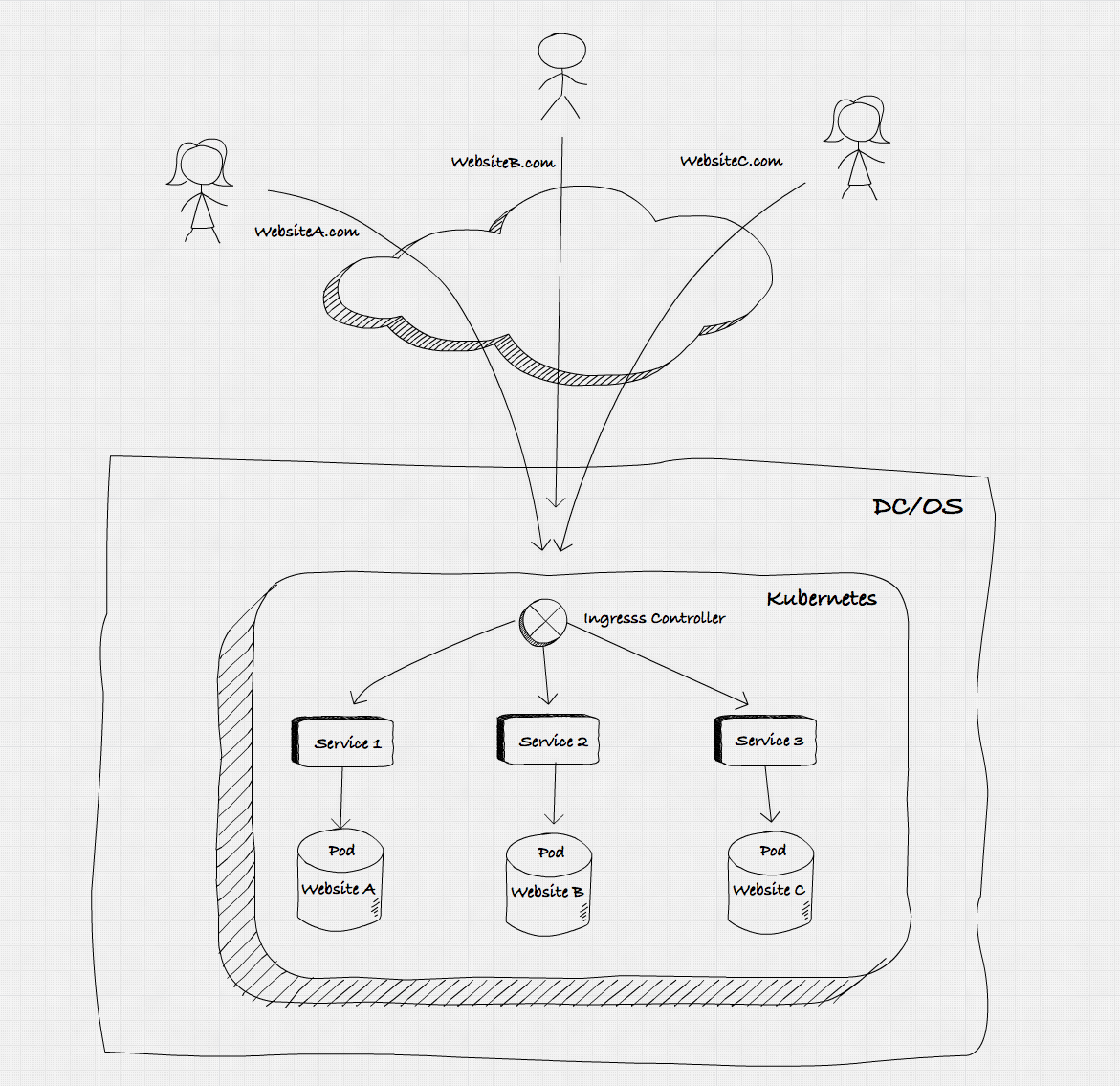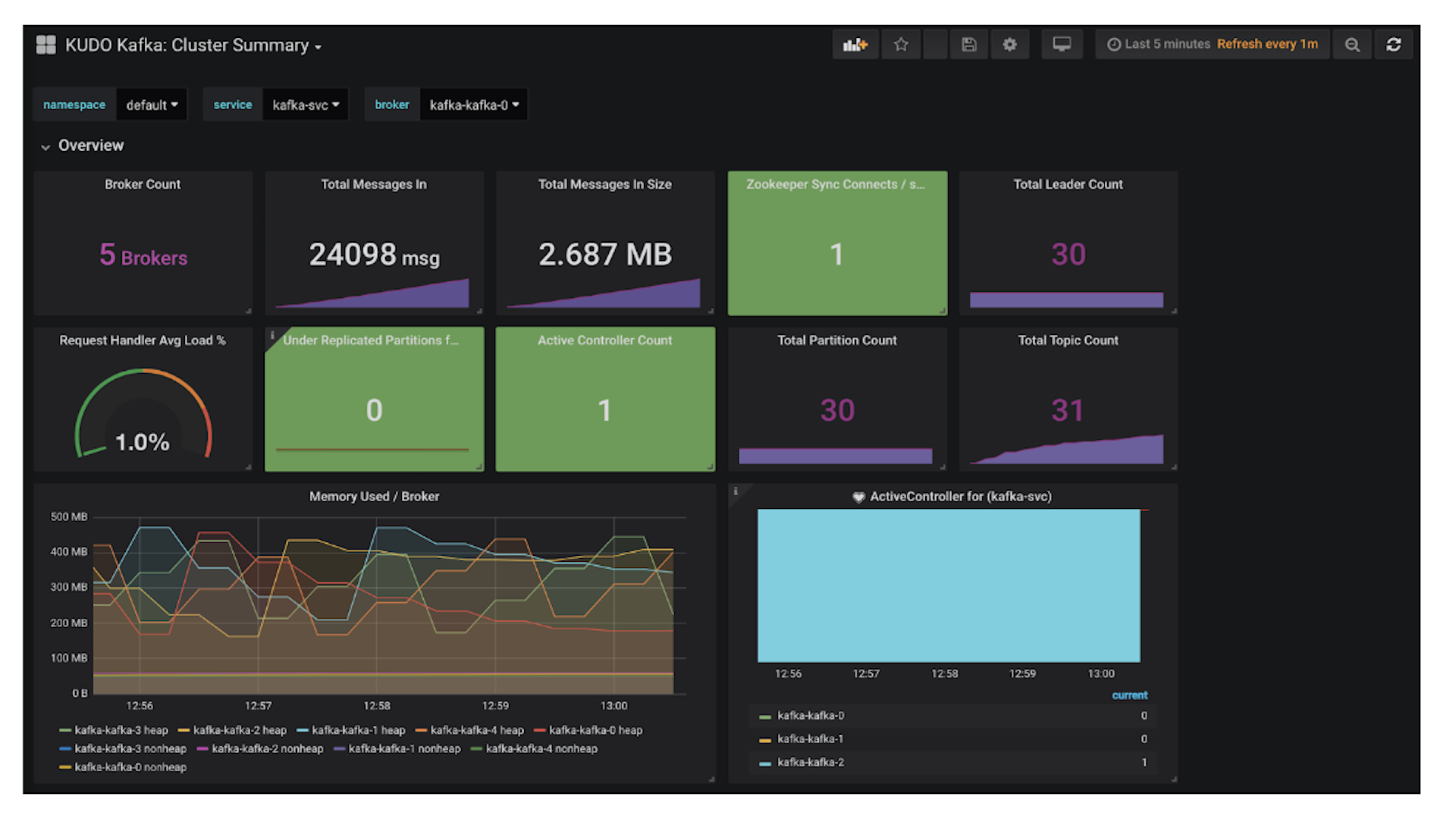Kubernetes and DC/OS are a powerful combination for serving the apps that create great customer experiences. Once your microservices-based containerized apps are up and running, you'll need to expose them to the outside world. This blog post explains several different ways to do this and provides detailed instructions for implementing an ingress controller.
Ingress Options Abound
Kubernetes handles East-West connectivity for services internally within our Kubernetes cluster by assigning a cluster-internal IP which can be reached by all services within the cluster. When it comes to external, or North-South, connectivity, there are a number of different methods we can use to achieve this.
Firstly, we can define a NodePort Service type. This exposes the service on a static port at each node's IP. Any traffic sent to that port on a node is forwarded to the relevant service.
For platforms that support it, such as AWS or GCP, we can define a LoadBalancer service, which will configure an external load balancer specifically for our service. Whilst this works well on cloud platforms, it can also be very expensive, as we may end up with many load balancer services.
The most flexible, although often the most confusing for new users, option is the Ingress Controller. An Ingress Controller can sit in front of many services within our cluster, routing traffic to them and depending on the implementation, can also add functionality like SSL termination, path rewrites, or name based virtual hosts. From an architecture perspective, ingress controllers are generally an automation layer integrated with a backend proxy service, and can generally operate at both layer 4 and layer 7.
There is a growing ecosystem of ingress controllers, some leveraging well known load balancers and proxies, and some new cloud native implementations. There are ingress controllers for most of the familiar tools in this space, like HAProxy and NGinx, alongside new Kubernetes native implementations like
Ambassador and
Contour , both of which leverage the
Envoy proxy. There are also implementations to use other cloud native proxy tools like
Traefik and
Kong , along with controllers which integrate with hardware load balancers such as those from
F5.
Exposing Services on Kubernetes with the NGinx Ingress Controller
The ingress type is relatively new, and the space is developing very rapidly, so for the purposes of this blog we're going to look at one of the most mature implementations, the NGinx ingress controller. It's worth noting there are a couple of different implementations of an Nginx ingress controller, with the two most noteworthy being Nginx's own implementation, and the Kubernetes community implementation.
We're going to be using the community implementation, and
here's the code for it.
The first step we're going to need to do is to deploy a default backend service. This is used by the Nginx ingress controller in the event that services are unavailable. The default backend image needs to satisfy two requirements :
- Serve a 404 page at /
- Respond with a 200 for requests to /healthz
The ingress-nginx project provides us with a
template yaml to use for this purpose, and the only change we've made from the defaults is to remove the namespace.
---apiVersion: extensions/v1beta1kind: Deploymentmetadata:name: default-http-backendlabels:app: default-http-backendspec:replicas: 1selector:matchLabels:app: default-http-backendtemplate:metadata:labels:app: default-http-backendspec:terminationGracePeriodSeconds: 60containers:- name: default-http-backend# Any image is permissible as long as:# 1. It serves a 404 page at /# 2. It serves 200 on a /healthz endpointimage: gcr.io/google_containers/defaultbackend:1.4livenessProbe:httpGet:path: /healthzport: 8080scheme: HTTPinitialDelaySeconds: 30timeoutSeconds: 5ports:- containerPort: 8080resources:limits:cpu: 10mmemory: 20Mirequests:cpu: 10mmemory: 20Mi---apiVersion: v1kind: Servicemetadata:name: default-http-backendlabels:app: default-http-backendspec:ports:- port: 80targetPort: 8080selector:app: default-http-backend
As we can see, this is going to deploy a single replica of the defaultbackend container, which we are getting from gcr.io, and our service will route port 80 requests to port 8080 on the target.
Mattbook-Pro:ingress matt$ kubectl create -f default-backend.yamldeployment "default-http-backend" createdservice "default-http-backend" created
Now we have our default backend, we can go ahead and deploy our nginx ingress controller. This will deploy both Nginx and the additional code for Kubernetes to control it. In the interests of clarity, we're going to deploy a very simple version of this configuration, it's worth
reading the docs to understand the full scope of the functionality.
apiVersion: extensions/v1beta1kind: Deploymentmetadata:name: nginx-ingress-controllerspec:replicas: 1revisionHistoryLimit: 3template:metadata:labels:k8s-app: ingress-nginxspec:containers:- args:- /nginx-ingress-controller- "--default-backend-service=$(POD_NAMESPACE)/default-http-backend"env:- name: POD_NAMEvalueFrom:fieldRef:fieldPath: metadata.name- name: POD_NAMESPACEvalueFrom:fieldRef:fieldPath: metadata.namespaceimage: "quay.io/kubernetes-ingress-controller/nginx-ingress-controller:0.15.0"imagePullPolicy: AlwayslivenessProbe:httpGet:path: /healthzport: 10254scheme: HTTPinitialDelaySeconds: 10timeoutSeconds: 5name: nginx-ingress-controllerports:- containerPort: 80hostPort: 80name: httpprotocol: TCPterminationGracePeriodSeconds: 60nodeSelector:kubernetes.dcos.io/node-type: publictolerations:- key: "node-type.kubernetes.dcos.io/public"operator: "Exists"effect: "NoSchedule"---Mattbook-Pro:ingress matt$ kubectl create -f nginx-controller-simple.yamldeployment "nginx-ingress-controller" created
There are a few things worth noting in this configuration, which are specific to deploying this in DC/OS. Firstly, we need to ensure that this is deployed to our public agents, which is defined by:
nodeSelector:kubernetes.dcos.io/node-type: public
We have also defined some tolerations that define the behavior we want to ensure if that condition can't be met. In this case, we are defining that unless we have a public node available, then we're not going to schedule the deployment.
tolerations:- key: "node-type.kubernetes.dcos.io/public"operator: "Exists"effect: "NoSchedule"
We've also bound the deployment container directly to port 80 on the host it is deployed onto:
ports:- containerPort: 80hostPort: 80name: httpprotocol: TCP
We could define a Service, and then have the ports allocated automatically by Kubernetes using a NodePort type, but DC/OS already exposes port 80 on public agents, so this simplifies our configuration. In a production environment, this may not be the best option, since we need to manually ensure that no other processes are using port 80 on any of our DC/OS public agents. This includes any scenario where you are running marathon-lb in it's default configuration, since marathon-lb binds to port 80 on public agents and so will prevent this ingress configuration from working correctly.
If we wanted to use the NodePort type, we would remove the hostPort line from the above configuration, and then define a Service which would look something like:
apiVersion: v1kind: Servicemetadata:name: ingress-nginxspec:type: NodePortports:- name: httpport: 80protocol: TCPselector:k8s-app: ingress-nginx
In the NodePort configuration we would need to find the ports the ingress controller is actually using by running :
Mattbook-Pro:ingress matt$ kubectl describe svc ingress-nginx | grep NodePortType: NodePortNodePort: http 31585/TCP
Once we have the port, we would need to ensure we can connect externally to those ports, by checking firewall rules and access controls. We would then connect to our endpoint using:
Mattbook-Pro:ingress matt$ curl 54.171.202.99:31585
Now back to our example implementation. Once our ingress controller is running, we can test connectivity to our public IP address. In order to find the public IP's of your DC/OS cluster, you can refer to the relevant
documentation. If you're running in AWS as I am, you can also use the handy
DC/OS CLI extension for doing exactly this. I only have a single public agent in my cluster, so using the CLI extension only returns me one result.
Mattbook-Pro:ingress matt$ dcos dcos-aws-cli publicIPs54.171.202.99
Once we have our public IP, we can use curl to connect to port 80 on this host.
Mattbook-Pro:ingress matt$ curl 54.171.202.99default backend - 404
We can see from the response code that we're hitting our default backend, which is exactly what the expected behaviour is since we don't yet have any ingress configuration.
Let's go ahead and deploy a simple service we can use for our first test of the ingress controller. We're going to use
---apiVersion: apps/v1kind: Deploymentmetadata:name: hello-worldlabels:app: hello-worldspec:replicas: 2selector:matchLabels:app: hello-worldtemplate:metadata:labels:app: hello-worldspec:containers:- name: echo-serverimage: hashicorp/http-echoargs:- -listen=:80- -text="Hello from Kubernetes!"ports:- containerPort: 80---apiVersion: v1kind: Servicemetadata:name: hello-worldspec:selector:app: hello-worldports:- port: 80targetPort: 80
Lets go ahead and deploy that :
Mattbook-Pro:ingress matt$ kubectl create -f helloworld.yamldeployment "hello-world" createdservice "hello-world" created
We now need to define an Ingress for the ingress controller to configure external access to our test application.
Mattbook-Pro:ingress matt$ cat helloworld-ingress.yamlapiVersion: extensions/v1beta1kind: Ingressmetadata:name: hello-world-ingressannotations:kubernetes.io/ingress.class: "nginx"spec:rules:- host: api.example.comhttp:paths:- path: /backend:serviceName: hello-worldservicePort: 80
In this configuration, we use an annotation to define which ingress class Kubernetes should use, we define the backend we should use, in this case our hello-world service, and we define the host, path and port which the ingress should be used on.
Mattbook-Pro:ingress matt$ kubectl create -f helloworld-ingress.yamlingress "hello-world-ingress" created
In order to test this, we need to do some local configuration on our kubectl host to map api.example.com to the public IP of our DC/OS cluster. This will depend on your operating system, but on MacOS and Linux you will want to add an entry in your /etc/hosts file as below :
Mattbook-Pro:ingress matt$ cat /etc/hosts### Host Database## localhost is used to configure the loopback interface# when the system is booting. Do not change this entry.##127.0.0.1 localhost255.255.255.255 broadcasthost::1 localhost54.171.202.99 api.example.com
With that entry in our /etc/hosts file, we can now resolve api.example.com to the public IP of our DC/OS cluster, so we can use curl once again to test out the ingress rule.
Mattbook-Pro:ingress matt$ curl api.example.com"Hello from Kubernetes!"
Success ! We see that our request has been routed to the correct service. We can also test that if we use the IP address instead of the hostname, then we hit the default backend with a 404 response, as expected.
Mattbook-Pro:ingress matt$ curl 54.171.202.99default backend - 404
Let's add a second service, which does something slightly different :
Mattbook-Pro:ingress matt$ cat holamundo.yaml---apiVersion: apps/v1kind: Deploymentmetadata:name: hola-mundolabels:app: hola-mundospec:replicas: 2selector:matchLabels:app: hola-mundotemplate:metadata:labels:app: hola-mundospec:containers:- name: echo-serverimage: hashicorp/http-echoargs:- -listen=:80- -text="Hola de Kubernetes!"ports:- containerPort: 80---apiVersion: v1kind: Servicemetadata:name: hola-mundospec:selector:app: hola-mundoports:- port: 80targetPort: 80Mattbook-Pro:ingress matt$ kubectl create -f holamundo.yamldeployment "hola-mundo" createdservice "hola-mundo" created
And now let's configure ingress to this on a different path to the same host :
Mattbook-Pro:ingress matt$ cat holamundo-ingress.yamlapiVersion: extensions/v1beta1kind: Ingressmetadata:name: holamundo-ingressannotations:kubernetes.io/ingress.class: "nginx"spec:rules:- host: api.example.comhttp:paths:- path: /holabackend:serviceName: hola-mundoservicePort: 80Mattbook-Pro:ingress matt$ kubectl create -f holamundo-ingress.yamlingress "holamundo-ingress" created
Now when we curl our endpoints, we can see that on the root we have our first service, and on the /hola endpoint we have our new service.
Mattbook-Pro:ingress matt$ curl api.example.com"Hello from Kubernetes!"Mattbook-Pro:ingress matt$ curl api.example.com/hola"Hola de Kubernetes!"
Let's try something different, first let's add another couple of host entries to our /etc/hosts file :
Mattbook-Pro:ingress matt$ cat /etc/hosts### Host Database## localhost is used to configure the loopback interface# when the system is booting. Do not change this entry.##127.0.0.1 localhost255.255.255.255 broadcasthost::1 localhost54.171.202.99 api.example.com54.171.202.99 es.example.com54.171.202.99 gb.example.com
And now let's add some host based routing to our ingress configuration:
Mattbook-Pro:ingress matt$ cat hosts-ingress.yamlapiVersion: extensions/v1beta1kind: Ingressmetadata:name: hosts-ingressannotations:kubernetes.io/ingress.class: "nginx"spec:rules:- host: gb.example.comhttp:paths:- path: /backend:serviceName: hello-worldservicePort: 80- host: es.example.comhttp:paths:- path: /backend:serviceName: hola-mundoservicePort: 80Mattbook-Pro:ingress matt$ kubectl create -f hosts-ingress.yamlingress "hosts-ingress" created
With this configuration we basically have name based virtual hosts, where depending on the host requested we route the traffic differently. Here we are just using the root path, but of course, we can also combine this with paths for a ton of flexibility.
Mattbook-Pro:ingress matt$ curl gb.example.com"Hello from Kubernetes!"Mattbook-Pro:ingress matt$ curl es.example.com"Hola de Kubernetes!"
We can even do path rewrites in our ingress rules :
Mattbook-Pro:ingress matt$ cat rewrite.yamlapiVersion: extensions/v1beta1kind: Ingressmetadata:name: rewriteannotations:ingress.kubernetes.io/rewrite-target: /oldkubernetes.io/ingress.class: "nginx"spec:rules:- host: "api.example.com"http:paths:- path: /newbackend:serviceName: hello-worldservicePort: 80
Using the ingress.kubernetes.io/rewrite-target annotation, we can ensure that any requests to /old will be rewritten to direct to /new.
I've actually only covered a small subset of the functionality that the NGinx ingress controller can provide, including sticky sessions, TLS termination and proxy protocol, so it's well worth
digging into the docs for further reading.
Ingress Controllers Expose Apps Running in Kubernetes on DC/OS
Hopefully we can now see that ingress controllers provide us with a powerful resource to control access to our applications running in Kubernetes on DC/OS. This is a space that's moving very fast, so we'll likely see more innovation around ingress over the coming months, and I'll be trying to cover more of the options for ingress into DC/OS in future blog posts.












